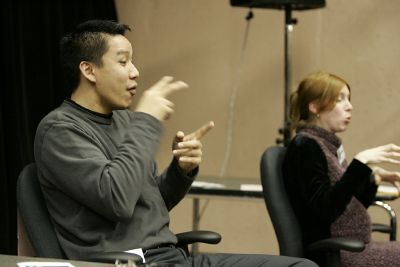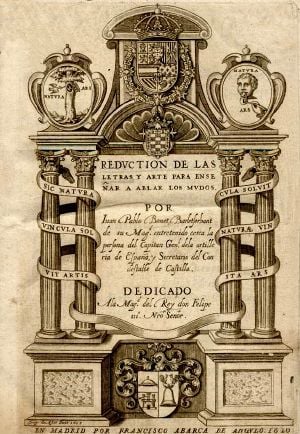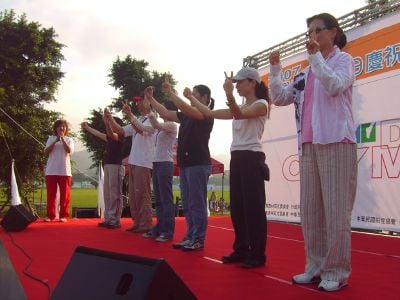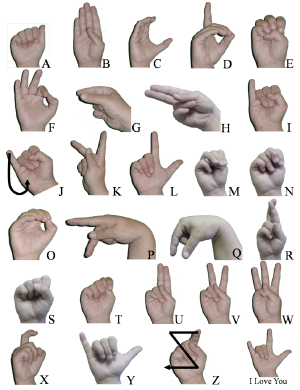Sign language
A sign language (also signed language) is a language which uses manual communication, body language, and lip patterns instead of sound to convey meaningâsimultaneously combining hand shapes, orientation and movement of the hands, arms or body, and facial expressions to fluidly express a speaker's thoughts. Signs often represent complete ideas, not only words. However, in addition to accepted gestures, mime, and hand signs, sign language often includes finger spelling, which involves the use of hand positions to represent the letters of the alphabet.
Although often misconceived of as an imitation or simplified version of oral language, linguists such as William Stokoe have found sign languages to be complex and thriving natural languages, complete with their own syntax and grammar. In fact, the complex spatial grammars of sign languages are markedly different than that of spoken language.
Sign languages have developed in circumstances where groups of people with mutually unintelligible spoken languages found a common base and were able to develop signed forms of communication. A well-known example of this is found among Plains Indians, whose lifestyle and environment was sufficiently similar despite no common base in their spoken languages, that they were able to find common symbols that were used to communicate even complex narratives among different tribes.
Sign languages commonly develop in deaf communities, which include people who are deaf or hard of hearing, friends and families of deaf people, as well as interpreters. In many cases, various signed "modes" of spoken languages have been developed, such as Signed English and Warlpiri Sign Language. Sign language differs from one region to another, just as do spoken languages, and are mutually unintelligible. Hundreds of sign languages are in use around the world and are at the core of local deaf cultures. The use of these languages has enabled the deaf to be recognized as intelligent, educable people who are capable of living life as fully and with as much value as anyone else. However, much controversy exists over whether teaching deaf children sign language is ultimately more beneficial than methods that allow them to understand oral communication, such as lip-reading, since this enables them to participate more directly and fully in the wider society. Nonetheless, for those people who remain unable to produce or understand oral language, sign language provides a way to communicate within their society as full human beings with a clear cultural identity.
History and development of sign language
On the whole, deaf sign languages are independent of oral languages and follow their own paths of development, even in situations where there may be a common spoken language. Because they developed on their own, British Sign Language and American Sign Language are quite different and mutually unintelligible, even though the hearing people of Britain and America share the same oral language. American Sign Language does have some similarities to French Sign Language, due to its early influences. When people using different signed languages meet, however, communication can be easier than when people of different spoken languages meet. This is not because sign languages are universal, but because deaf people may be more patient when communicating, and are comfortable including gesture and mime.[1]
Generally, each spoken language has a sign language counterpart because each linguistic population contains deaf members who generated a sign language. Geographical or cultural forces will isolate populations and lead to the generation of different and distinct spoken languages; the same forces operate on signed languages, therefore they tend to maintain their identities through time in roughly the same areas of influence as the local spoken languages. This occurs even though sign languages have little or no relation to the spoken languages of the lands in which they arise. There are notable exceptions to this pattern, however, as some geographic regions sharing a spoken language have multiple, unrelated signed languages. Variations within a "national" sign language can usually be correlated to the geographic location of (residential) schools for the deaf.
The written history of sign language began in the seventeenth century in Spain. In 1620, Juan Pablo Bonet published Reducción de las letras y arte para enseñar a hablar a los mudos (Reduction of letters and art for teaching dumb people to speak) in Madrid. It is considered the first modern treatise of phonetics and speech therapy, setting out a method of oral education for the deaf people by means of the use of manual signs in the form of a manual alphabet to improve the communication of deaf people.
From the language of signs of Bonet, Charles-Michel de l'Ãpée published his alphabet in the eighteenth century, which has remained basically unchanged until the present time. In 1755, Abbé de l'Ãpée founded the first public school for deaf children in Paris. His lessons were based upon his observations of deaf people signing with hands in the streets of Paris. Synthesized with French grammar, it evolved into the French Sign Language.
Laurent Clerc, a graduate and former teacher of the French School, went to the United States with Thomas Hopkins Gallaudet to found the American School for the Deaf in Hartford, Connecticut, in 1817.[2] Others followed. In 1817, Clerc and Gallaudet founded the American Asylum for the Deaf and Dumb (now the American School for the Deaf). Gallaudet's son, Edward Miner Gallaudet, founded the first college for the deaf in 1864 in Washington, DC, which in 1986, became Gallaudet University, the only liberal arts university for the deaf in the world.
International Sign, formerly known as "Gestuno," was created in 1973, to enhance communication among members of the deaf community throughout the world. It is an artificially constructed language and though some people are reported to use it fluently, it is more of a pidgin than a fully formed language. International Sign is used mainly at international Deaf events such as the Deaflympics and meetings of the World Federation of the Deaf.[4]
Linguistics of sign
In linguistic terms, sign languages are rich and complex, despite the common misconception that they are not "real languages." William Stokoe started groundbreaking research into sign language in the 1960s. Together with Carl Cronenberg and Dorothy Casterline, he wrote the first sign language dictionary, A Dictionary of American Sign Language on Linguistic Principles.[5] It was during this time he first began to refer to sign language not just as sign language or manual communication, but as "American Sign Language," or ASL. This ground-breaking dictionary listed signs and explained their meanings and usage, and gave a linguistic analysis of the parts of each sign. Since then, linguists have studied many sign languages and found them to have every linguistic component required to be classified as true languages.
Sign languages are not merely pantomime, but are made of largely arbitrary signs that have no necessary visual relationship to their referent, much as most spoken language is not onomatopoeic. Nor are they a visual renditions of an oral language. They have complex grammars of their own, and can be used to discuss any topic, from the simple and concrete to the philosophical and abstract. For example, in terms of syntax, ASL shares more with spoken Japanese than it does with English.[6]
Sign languages, like oral languages, organize elementary, meaningless units (phonemes; once called cheremes in the case of sign languages) into meaningful semantic units. The elements of a sign are Hand shape (or Handform), Orientation (or Palm Orientation), Location (or Place of Articulation), Movement, and Non-manual markers (or Facial Expression), summarized in the acronym HOLME. Signs, therefore, are not an alphabet but rather represent words or other meaningful concepts.
In addition to such signs, most sign languages also have a manual alphabet. This is used mostly for proper names and technical or specialized vocabulary. The use of fingerspelling was once taken as evidence that sign languages are simplified versions of oral languages, but it is merely one tool in complex and vibrant languages. Fingerspelling can sometimes be a source of new signs, which are called lexicalized signs.
Common linguistic features of deaf sign languages are extensive use of classifiers, a high degree of inflection, and a topic-comment syntax. Many unique linguistic features emerge from sign languages' ability to produce meaning in different parts of the visual field simultaneously. For example, the recipient of a signed message can read meanings carried by the hands, the facial expression, and the body posture at the same time. This is in contrast to oral languages, where the sounds that comprise words are mostly sequential (tone being an exception).
Spatial grammar and simultaneity
Sign languages are able to capitalize on the unique features of the visual medium. Oral language is linear and only one sound can be made or received at a time. Sign language, instead, is visual; hence, a whole scene can be taken in at once. Information can be loaded into several channels and expressed simultaneously.
As an illustration, in English one could utter the phrase, "I drove here." To add information about the drive, one would have to make a longer phrase or even add a second, such as, "I drove here along a winding road," or "I drove here. It was a nice drive." However, in American Sign Language, information about the shape of the road or the pleasing nature of the drive can be conveyed simultaneously with the verb "drive" by inflecting the motion of the hand, or by taking advantage of non-manual signals such as body posture and facial expression, at the same time that the verb "drive" is being signed. Therefore, in English the phrase "I drove here and it was very pleasant" is longer than "I drove here," in American Sign Language the two may be the same length.
Written forms of sign languages
Sign languages are not often written, and documented written systems were not created until after the 1960s. Most deaf signers read and write the oral language of their country. However, there have been several attempts at developing scripts for sign language. These have included both "phonetic" systems, such as Hamburg Sign Language Notation System, or HamNoSys,[7] and SignWriting, which can be used for any sign language, as well as "phonemic" systems such as the one used by William Stokoe in his 1965 Dictionary of American Sign Language, which are designed for a specific language.
The phonemic systems of oral languages are primarily sequential: That is, the majority of phonemes are produced in a sequence one after another, although many languages also have non-sequential aspects such as tone. As a consequence, traditional phonemic writing systems are also sequential, with at best diacritics for non-sequential aspects such as stress and tone. Sign languages have a higher non-sequential component, with many "phonemes" produced simultaneously. For example, signs may involve fingers, hands, and face moving simultaneously, or the two hands moving in different directions. Traditional writing systems are not designed to deal with this level of complexity.
The Stokoe notation is sequential, with a conventionalized order of a symbol for the location of the sign, then one for the hand shape, and finally one (or more) for the movement. The orientation of the hand is indicated with an optional diacritic before the hand shape. When two movements occur simultaneously, they are written one atop the other; when sequential, they are written one after the other. Stokoe used letters of the Latin alphabet and Arabic numerals to indicate the handshapes used in fingerspelling, such as "A" for a closed fist, "B" for a flat hand, and "5" for a spread hand; but non-alphabetic symbols for location and movement, such as "[]" for the trunk of the body, "Ã" for contact, and "^" for an upward movement.
SignWriting, developed in 1974 by Valerie Sutton, is highly featural and visually iconic, both in the shapes of the charactersâwhich are abstract pictures of the hands, face, and bodyâand in their spatial arrangement on the page, which does not follow a sequential order like the letters that make up written English words. Being pictographic, it is able to represent simultaneous elements in a single sign. Neither the Stokoe nor HamNoSys scripts were designed to represent facial expressions or non-manual movements, both of which SignWriting accommodates easily.
Use of signs in hearing communities
While not full languages, many elaborate systems of manual communication have developed in situations where speech is not practical or permitted, such as cloistered religious communities, scuba diving, television recording studios, loud workplaces, stock exchanges, in baseball, while hunting (by groups such as the Kalahari bushmen), or in the game Charades. In Rugby Union, the referee uses a limited but defined set of signs to communicate his/her decisions to the spectators.
On occasion, where there are enough deaf people in the area, a deaf sign language has been taken up by an entire local community. Famous examples of this include Martha's Vineyard Sign Language in the U.S., Kata Kolok in a village in Bali, Adamorobe Sign Language in Ghana, and Yucatec Maya sign language in Mexico. In such communities, deaf people are not socially disadvantaged.
Many Australian Aboriginal sign languages arose in a context of extensive speech taboos, such as during mourning and initiation rites. They are or were especially highly developed among the Warlpiri, Warumungu, Dieri, Kaytetye, Arrernte, Warlmanpa, and are based on their respective spoken languages.
Sign language has also been used to facilitate communication among peoples of mutually intelligible languages. In the case of Chinese and Japanese, where the same body of written characters is used but with different pronunciation, communication is possible through watching the "speaker" trace the mutually understood characters on the palm of their hand.
A pidgin sign language arose among tribes of American Indians in the Great Plains region of North America. Although the languages of the Plains Indians were unrelated, their way of life and environment had many common features. They were able to find common symbols which were then used to communicate even complex narratives among different tribes. For example, the gesture of brushing long hair down the neck and shoulders signified a woman, two fingers astride the other index finger represented a person on horseback, a circle drawn against the sky meant the moon, and so forth. Unlike other sign languages developed by hearing people, it shares the spatial grammar of deaf sign languages.
Home sign
Sign systems are sometimes developed within a single family. For instance, when hearing parents with no sign language skills have a deaf child, an informal system of signs will naturally develop, unless repressed by the parents. The term for these mini-languages is home sign (sometimes homesign or kitchen sign).
Home sign arises due to the absence of any other way to communicate. Within the span of a single lifetime and without the support or feedback of a community, the child is forced to invent signals to facilitate the meeting of his or her communication needs. Although this kind of system is grossly inadequate for the intellectual development of a child and does not meet the standards linguists use to describe a complete language, it is a common occurrence.
Benefits
For deaf and hard of hearing students, there have been long standing debates regarding the teaching and use of sign language versus oral methods of communication and lip reading. Proficiency in sign language gives deaf children a sense of cultural identity, which enables them to bond with other deaf individuals. This can lead to greater self-esteem and curiosity about the world, both of which enrich the student academically and socially. Certainly, the development of sign language showed that deaf-mute children were educable, opening educational opportunities at the same level as those who hear.
Notes
- â David Bar-Tzur, International Gesture:Principles and Gestures, July 13, 2002. Retrieved September 20, 2022.
- â Loida Canlas, Laurent Clerc: Apostle to the Deaf People of the New World Laurent Clerc National Deaf Education Center, Gallaudet University.
- â Juan Pablo Bonet, Reducción de las Letras y Arte para Enseñar a Hablar a los Mudos (Editorial Cepe, 1992, ISBN 978-8478690718).
- â Jolanta Lapiak, Gestuno (a.k.a International Sign Language) HandSpeak. Retrieved September 20, 2022.
- â William C. Stokoe, Dictionary of American Sign Language on Linguistic Principles (Linstok Press, 1976, ISBN 978-0932130013).
- â Karen Nakamura, About Japanese Sign Language Deaf Resource Library. Retrieved September 20, 2022.
- â HamNoSys DGS Corpus. Retrieved September 20, 2022.
ReferencesISBN links support NWE through referral fees
- Aronoff, Mark, and Janie Rees-Miller. The Handbook of Linguistics. Malden, MA: Wiley-Blackwell, 2020. ISBN 978-1119302070
- Bonet, Juan Pablo. Reducción de las Letras y Arte para Enseñar a Hablar a los Mudos. Editorial Cepe, 1992. ISBN 978-8478690718
- Emmorey, Karen, Harlan L. Lane, Ursula Bellugi, and Edward S. Klima. The Signs of Language Revisited: An Anthology to Honor Ursula Bellugi and Edward Klima. Mahwah, NJ: Lawrence Erlbaum Associates, 2000. ISBN 978-0585356419
- Groce, Nora Ellen. Everyone Here Spoke Sign Language: Hereditary Deafness on Martha's Vineyard. Cambridge, MA: Harvard University Press, 1985. ISBN 978-0674270404
- Kendon, Adam. Sign languages of Aboriginal Australia Cultural, Semiotic, and Communicative Perspectives. Cambridge: Cambridge University Press, 1989. ISBN 0521360080
- Klima, Edward S., and Ursula Bellugi. The Signs of Language. Cambridge, MA: Harvard University Press, 1979. ISBN 978-0674807952
- Lane, Harlan L. The Deaf Experience Classics in Language and Education. Cambridge, MA: Harvard University Press, 1984. ISBN 978-0674194601
- Lane, Harlan L. When the Mind Hears: A History of the Deaf. New York: Random House, 1984. ISBN 0394508785
- Lucas, Ceil. Multicultural Aspects of Sociolinguistics in Deaf Communities: Sociolinguistics in Deaf Communities, vol. 2. Washington, DC: Gallaudet University Press, 1996. ISBN 978-1563680465
- Padden, Carol, and Tom Humphries. Deaf in America: Voices from a Culture. Cambridge, MA: Harvard University Press, 1988. ISBN 978-0674194236
- Poizner, Howard. What the Hands Reveal about the Brain. Cambridge, MA: MIT Press, 1987. ISBN 978-0262161053
- Sacks, Oliver W. Seeing Voices: A Journey into the Land of the Deaf. Vintage, 2000. ISBN 978-0375704079
- Stiles, Joan, Mark Kritchevsky, and Ursula Bellugi. Spatial Cognition: Brain Bases and Development. Hillsdale, NJ: L. Erlbaum Associates, 1988. ISBN 978-0805800463
- Stokoe, William C. Dictionary of American Sign Language on Linguistic Principles. Linstok Press, 1976. ISBN 978-0932130013
- Stokoe, William C. Sign Language Structure: An Outline of the Visual Communication Systems of the American Deaf. Linstok Press, 1978. ISBN 978-0932130037
- Tomkins, William. Indian Sign Language. Dover Publications, 1969. ISBN 978-0486220291
External links
All links retrieved January 29, 2023.
- ABC Slider Learn ASL fingerspelling
- ASL Browser Video dictionary of ASL signs
- 32 Uses and Benefits of American Sign Language (ASL) for Silent Communications
- Why Is It Important to Learn American Sign Language (ASL)?
- Top 26 Resources for Learning Sign Language
Credits
New World Encyclopedia writers and editors rewrote and completed the Wikipedia article in accordance with New World Encyclopedia standards. This article abides by terms of the Creative Commons CC-by-sa 3.0 License (CC-by-sa), which may be used and disseminated with proper attribution. Credit is due under the terms of this license that can reference both the New World Encyclopedia contributors and the selfless volunteer contributors of the Wikimedia Foundation. To cite this article click here for a list of acceptable citing formats.The history of earlier contributions by wikipedians is accessible to researchers here:
The history of this article since it was imported to New World Encyclopedia:
Note: Some restrictions may apply to use of individual images which are separately licensed.











